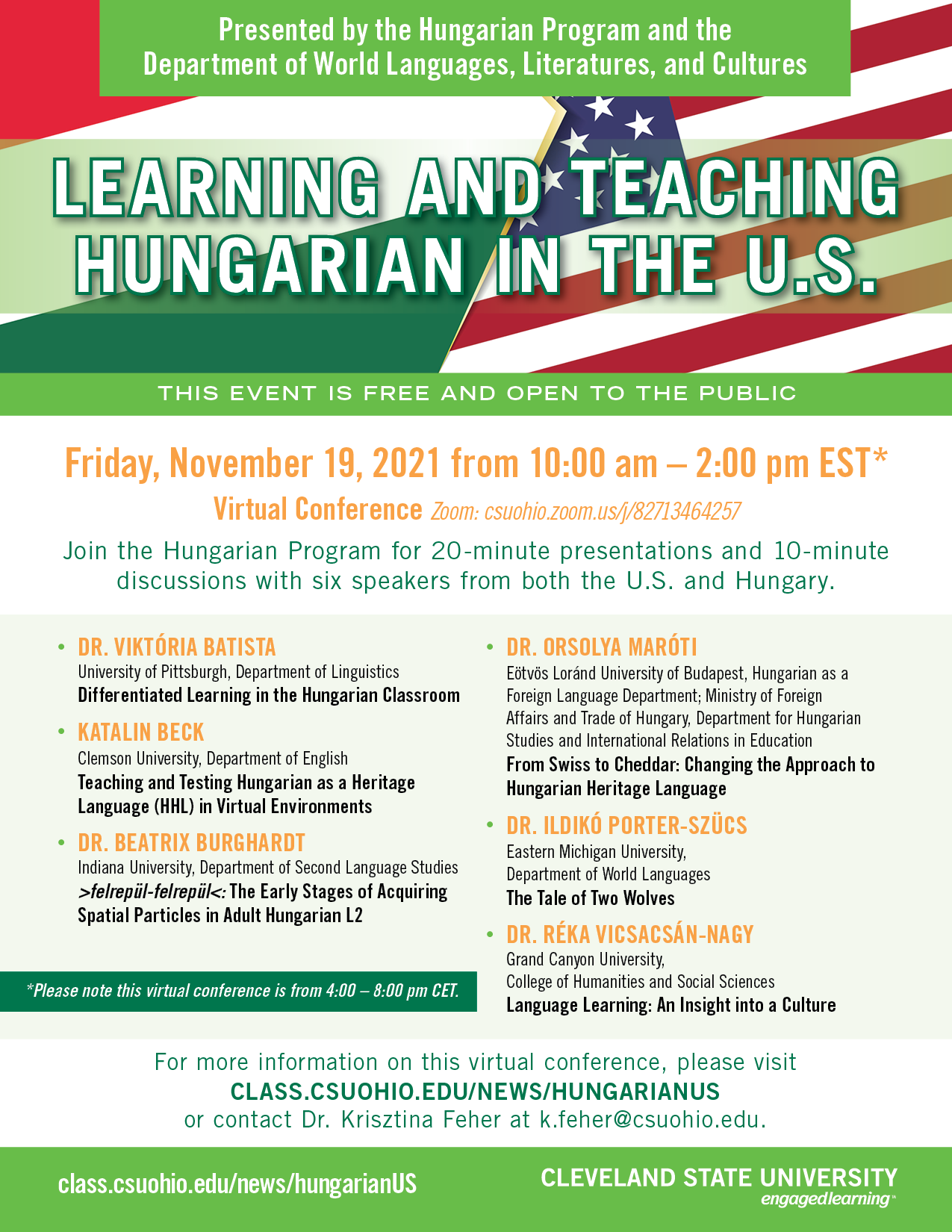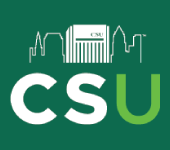Posted on October 21, 2021 at 12:17 PM, updated August 25, 2022 at 9:02 AM Print
Friday, November 19, 2021
from 10:00 am – 2:00 pm EST*
Virtual Conference
(*Please note this virtual conference is from 4:00 – 8:00 pm CET)
Zoom: https://csuohio.zoom.us/j/82713464257
This event is free and open to the public
Presented by the Hungarian Program and the Department of World Languages, Literatures, and Cultures at Cleveland State University
Learning and teaching Hungarian in the U.S.
There will be 20-minute presentations and 10-minute discussions with six invited speakers from the U.S. and Hungary.
For more information or for questions, please contact Dr. Krisztina Feher (k.feher@csuohio.edu).
| Click Here to download the Program for this conference |
|---|
https://engagedscholarship.csuohio.edu/hungarianconferences/fall2021/
Abstracts
Dr. Batista, Viktória (the University of Pittsburgh, Department of Linguistics):
Differentiated Learning in the Hungarian Classroom
Along with other subjects where the need for differentiated instruction became standard, the area of second language development has also been calling for person-centered approaches instead of “one-size-fits-all” teaching practices (see e.g. Benson, 2017; Larsen-Freeman, 2018; Godwin-Jones, 2021). While differentiated learning is a goal that instructors in all areas should be aspiring to, a relatively small class size and a less commonly taught language are factors that tend to make the teaching and learning of Hungarian an area where paying special attention to the needs and skills of students is of great importance in facilitating language development. Besides the differences one may encounter in other subjects, e.g. non-traditional students or those who need special accommodations because of a disability, learners in a language class may also include heritage speakers. Small class sizes in the case of a less commonly taught language like Hungarian translate into more individual attention by the instructor, more opportunities for learners to engage in language production, as well as the necessity to make sure class dynamics work at all times with all members of the group. This presentation discusses best practices of differentiated learning in Hungarian language courses at the University of Pittsburgh.
Beck, Katalin (Clemson University, Department of English):
Teaching and Testing Hungarian as a Heritage Language (HHL) in Virtual Environments
The recent shift to online education accelerated the need to better understand and accommodate the unique needs and characteristics of “Hungarian as Heritage Language” (HHL) learners who study in virtual environments. Additionally, to ensure the quality and sustainability of teaching Hungarian in the US diaspora, a systematic framework is called for. My presentation proposes that the competence-based examination system of the ECL exam (European Consortium for the Attainment of Modern Languages exam) can be a fitting answer to this call. I will discuss the findings of my research on adopting and using ECL testing materials in digital Learning Management Systems (LMSs). My research examined the results of the pilot tests that preceded the deployment of an online Hungarian ECL testing platform. Leveraging a body of knowledge about the role of information and communication technology (ICT) in language education, online teaching experiences in the Hungarian Diaspora community, and test-administration experiences in the ECL framework, digital testing materials were developed in three competency areas: reading, writing, and listening. The pilot test informs about how suitable the chosen LMS platform and the content are to the needs of heritage speakers, and my findings will be instrumental in further development of teaching and testing materials for HHL education. My presentation aims to benefit educators who are working in diaspora communities and interested in online teaching technologies.
Dr. Burghardt, Beatrix (Indiana University, Department of Second Language Studies):
>felrepül-felrepül<: The Early Stages of Acquiring Spatial Particles in Adult Hungarian L2
This talk explores the interlanguage development of adult L2/L3 learners of Hungarian in the domain of spatial boundedness. Taking a form-oriented approach, it reports on the early stages of acquisition by examining the distribution of spatial particles, e.g., ki (‘out’), be (‘in’), in bounded vs. unbounded motion expressions.
Thirty-five learners of Hungarian, studying in the host or foreign language environment (Pica, 1985), completed a personalized narrative retell task (Bardovi-Harlig, 2000). Original materials were designed to provide multiple opportunities for production in a balance (Burghardt, 2019, 2015). Particle-verb (P^V) and verb-particle (V^P) predicates were predicted to occur in bounded and unbounded contexts, respectively. The retell task yielded a corpus of 505 motion clauses, which were submitted to analysis. Against predictions, the task elicited eight structurally different motion predicate types containing verbs, directional particles and their various combinations. These forms occurred in simplex and reduplicated predicates, and L2 learners employed these forms systematically to contrast bounded vs. unbounded motion events.
The use of reduplication in Hungarian L2 is a previously unreported finding in boundedness-related L2 acquisition research, and it is taken to be part of the pragmatic stage of L2 development, when grammatical means to render the bounded-unbounded semantic distinction are lacking. Taking a cross-linguistic perspective, though, reduplication is one attested means of encoding boundedness-related contrast in oral communication. Thus, these findings confirm that L2 grammar is not random but one possible human grammar in the languages of the world. Implications for Hungarian L2 teaching and research will be discussed.
Dr. Maróti, Orsolya (Eötvös Loránd University of Budapest, Hungarian as a Foreign Language Department; Ministry of Foreign Affairs and Trade of Hungary, Department for Hungarian Studies and International Relations in Education):
From Swiss to Cheddar: Changing the Approach to Hungarian Heritage Language
There are an estimated 1.411 million individuals of Hungarian heritage who reside and 25 to 30 Hungarian community schools that operate in the United States. The lecture examines the case of Hungarian Heritage Language students who either attended a community school or have registered to study in university courses. Within the field of language education research, this group of students was long underrepresented. Today, however, it can be said that the efforts of local communities, the many teacher training programs, and the teaching materials created by professional language educators have made strides in supporting those young adults who choose to study their HL.
Even for laypeople it is quite obvious that heritage learners are far more proficient orally compared to their written abilities. Their noticeable knowledge gap in writing skills often distracts educators from developing other areas.
Given that their attitude toward language education is what determines the educational tools used by the volunteer educators, I have examined the question of what language competencies the participants in our training sessions held in 2012 and 2018, which is defined as requiring development. My data clearly signals that weekend school instructors display a growing level of consciousness as teachers.
The lecture focuses on the areas that deserve attention in this special educational situation: developing teachers’ and students’ language awareness, viewing L1 from the outside and correcting errors with an interlanguage approach.
Dr. Porter-Szücs, Ildikó (Eastern Michigan University, Department of World Languages):
The Tale of Two Wolves
According to a Cherokee tale, inside every human are two wolves battling for control: one bad, the other one good. “Which one wins?” you may ask. “The one you feed,” sounds the answer. The presenter builds on the fundamental insight from this tale as she discusses how to maximize opportunities and minimize counterproductive practices when learning and teaching Hungarian from birth into adolescence in the U.S. The presenter draws on the fields of second language acquisition, brain-based research, human development, second- and foreign-language education as well as her personal experiences growing up bilingual, raising a trilingual child, founding and running a heritage-language school, and cultivating language preservation among children growing up with heritage languages. The presentation will be accessible to specialists and non-specialists alike and will close with time for questions.
Dr. Vicsacsán-Nagy, Réka (Grand Canyon University, College of Humanities and Social Sciences):
Language Learning: An Insight into a Culture
The Hungarian Cultural Association of Phoenix is one of those U.S. based non-profits that offers language learning to a variety of age groups. Its Napocska Hungarian School for children was started in 2016, while learning groups for adults have begun in 2020 with the start of the Covid pandemic. Language learning and cultural knowledge go hand in hand. The purpose of language learning is to get to know more about the Hungarian culture and at the same time it is more and more obvious that there is no effective language learning without cultural knowledge. In my presentation I aim to talk about the status of Hungarian language learning in Arizona and relate our experiences of connecting cultural knowledge with the process of language learning. Finally, I would like to emphasize that the combination of the two helped us the most achieve our organization’s mission which is to build bridges between cultures, improve intercultural communication between Hungarians and non-Hungarians.
| Click here to download Abstracts |
|---|
For more information or for questions, please contact Dr. Krisztina Feher (k.feher@csuohio.edu).


